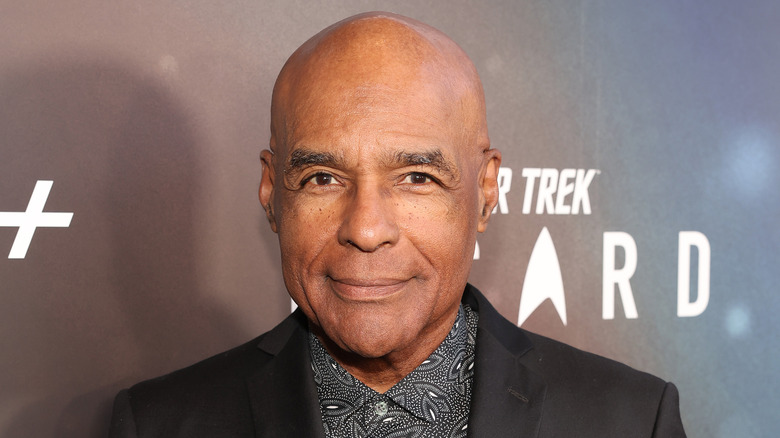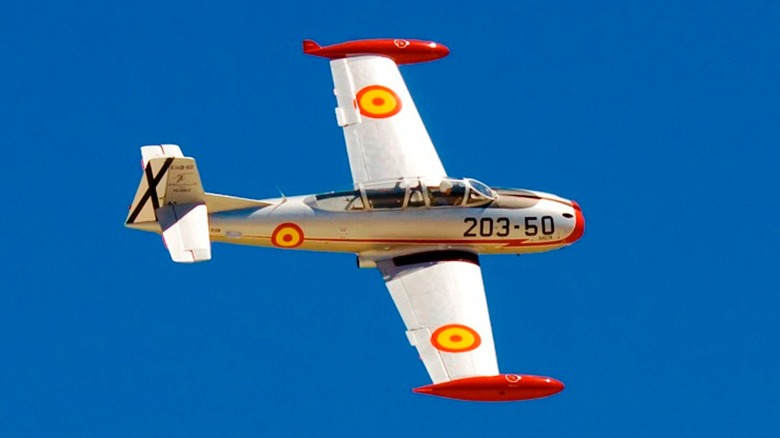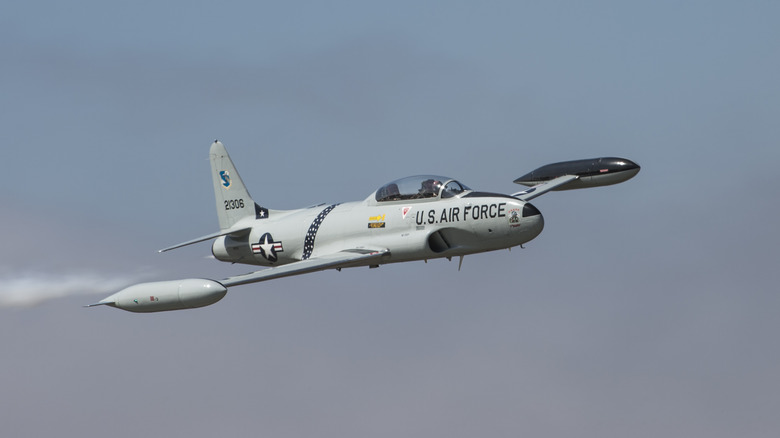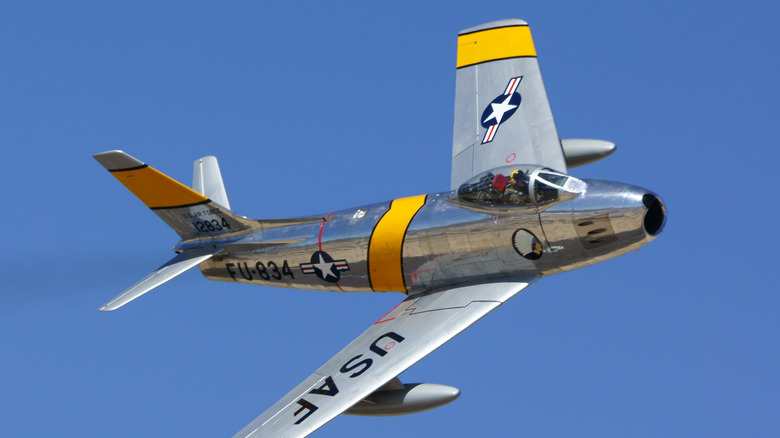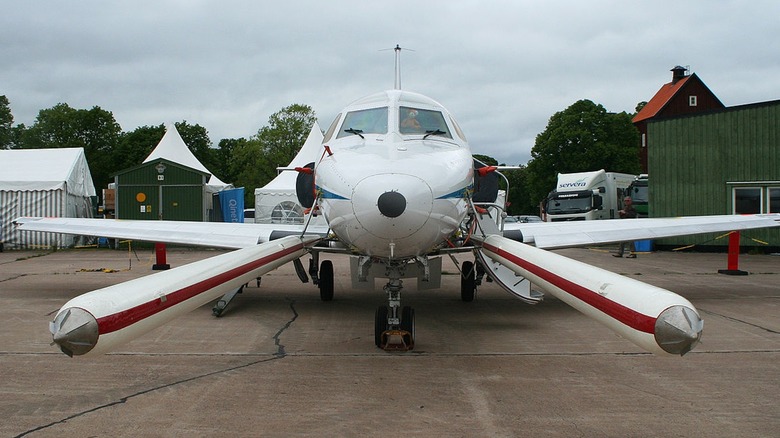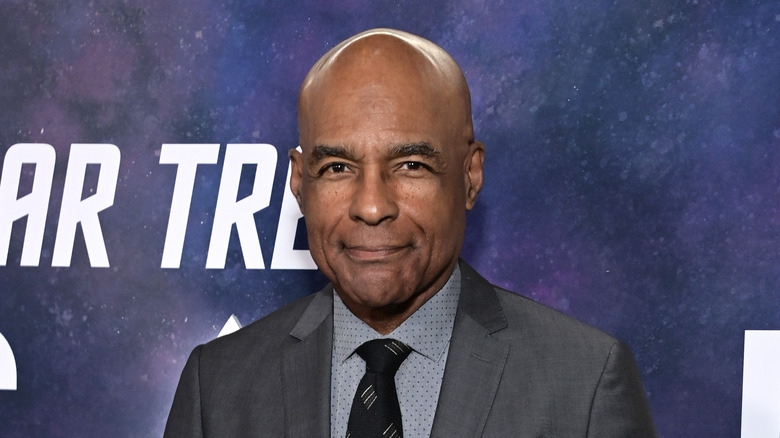Every Military Jet Ever Owned By Star Trek's Michael Dorn
Decades after it first took the science fiction genre by storm, the real-world technology-predicting "Star Trek" remains a juggernaut of a franchise loved and celebrated the world over. In its many years atop the pop culture heap, it has added extensively to its lore and expanded the timeline. As a result, numerous actors have come along to flesh the universe out and ultimately become entertainment legends. One of these many names is Michael Dorn, who is synonymous with the role of Starfleet figurehead Worf.
What many may not know about Dorn is that while he was exploring the fictional cosmos on "Star Trek," he was actually learning to get closer to the stars in real life. Dorn is a skilled pilot who, in addition to honing his craft as an aviator, has taken to collecting jets himself. The first aircraft he ever owned was a Socata Trinidad TB-20, paving the way for him to later acquire a Cessna 172, 310, and 340A, as well as a Beechcraft Baron 55.
Of course, this is only the tip of the iceberg when it comes to Dorn's aircraft collecting habits. Dorn has also become well-acquainted with military-grade jets throughout his time in the cockpit. Yes, there are some general military and fighter jets that you can actually buy, and he has purchased a handful over the years.
HA-200 Saeta
Michael Dorn's first foray into military jets came in the form of the HA-200 Saeta. Released by Hispano Aviacion and attributed largely to designer Willy Messerschmidt, this jet was conceived in the 1950s and eventually took to the skies officially in the 1960s. Once it did so, its two-person crew could get it to reach an impressive maximum speed of 429 mph with a rate of climb at approximately 3,345 feet per minute. The HA-200 was a staple of the Spanish Air Force until all units were retired in 1982. Thus, with quite a bit of piloting experience behind him, Dorn was able to get ahold of one.
During a chat with Airport Journals, Dorn recalled that buying and flying the HA-200 was a huge step for him. It forced him to adjust how he went about flying as he worked with a whole new style. "It was a tiny, twin-engine jet, but it got me acclimated to jet operations — how jets work and the speed and thinking way ahead," he said, adding that especially compared to his Cessna 340A, he had to really hone in on his landing procedures. "With the 340, you start coming down 15 or 20 miles away. With the jet, you have to be thinking 30 and 40 miles out, 'OK, I've got to start coming down.'"
Lockheed T-33 Shooting Star
The Lockheed T-33, known colloquially as the Shooting Star, was Michael Dorn's second military jet purchase. This craft made a name for itself as the only United States Air Force trainer jet from 1948 to 1957. Not to mention, its career saw it serve in 20 different countries' air forces, making its legacy a globally recognized one. Also manned by a two-person crew, it very much leaves the HA-200 in the dust with a max speed of around an astonishing 600 mph. The T-33 went into retirement in 1987, with many of its models going on to become display pieces, but it remains quite well-known.
Much like the HA-200, the T-33 presented a learning curve for Dorn, as it's a far cry from the most advanced jets flying today. As reported by AV Buyer, he found the jet's responsiveness to be lacking a bit compared to other jets he'd flown. Still, despite its tank-like nature, he found flying it to be a valuable experience overall. Dorn felt it gave him a true sense of what it meant to fly a jet that his previous planes didn't quite deliver. In the end, though, the Worf actor chose not to keep the T-33 for the long haul, though Dorn held onto the aircraft for around three years before moving on to his next jet.
North American F-86 Sabre
Upon leaving his Lockheed T-33 behind, Michael Dorn moved on to another military classic, the North American F-86 Sabre. The history of this model dates back to the 1940s, with it first taking flight in October 1947. A variant of the model, the F-86A, set a world speed record with an impressive 670.9 mph. As it turns out, the F-86 can go a good bit faster, hitting a maximum speed of 685 mph. Multiple variations of the jet made headlines during the Korean Conflict of the early 1950s. In fact, they proved quite formidable against Russian MiG-15s — a predecessor of Russia's futuristic MiG-41 jet — destroying hundreds in battle. Nevertheless, the F-86 was retired by the United States Air Force in 1958.
Though its use in war has long since passed, Dorn still carries a deep appreciation for the F-86. During a conversation with Nerd Alert News, he highlighted it as quite an integral part of his military jet journey as far as he was concerned. He wanted to move from jet to jet just as one would in the Air Force, eventually working his way up to the F-86. With extensive study and plenty of experience behind other military jet cockpits, Dorn made it, and it was well worth the wait. "I went through the same type of process the Air Force pilots go through. And got to the F-86 and it just kinda happened. It was amazing," Dorn said in the interview.
North American Sabreliner 40A
The aircraft that Michael Dorn moved to from the F-86 Sabre is a bit different from the previous jets he'd flown. The North American Sabreliner 40A is more of a transport craft than a standard jet, capable of moving up to seven people across vast distances. With that said, it's no slouch in the speed department, maxing out at just over 550 mph. The Sabreliner line launched in the early 1960s, and production concluded at the start of the 1980s. Now, decades beyond the end of Sabreliner's manufacturing, there are still hundreds operating in the modern era. Unfortunately, the 40A didn't necessarily blow Dorn away.
"It was a bad choice, because with those corporate jets, you need a copilot. Then, you're at the mercy of your copilots... I was bored out of my skull. You take off, and you have your arms crossed for two hours," the "Star Trek" icon told Airport Journals of his rather dull experience in the 40A's cockpit. Not to mention, upkeep costs were quite high, so Dorn eventually let the Sabreliner go in pursuit of a new military jet.
Dorn's flying future
With the disappointing and costly North American Sabreliner 40A behind him, Michael Dorn wasted no time shopping around for his next military jet. Dorn has openly discussed two different jets he's had his eye on for some time. First is the Northrop T-38 Talon, which, having two engines and being moderately affordable, pushed him toward it. He more so expressed interest in getting his hands on a Northrop F-5 or a Vought F-8 Crusader, being particularly intrigued by the idea of fixing up the latter to take part in heritage flights.
In one of his more recent aviation-talk interviews, Dorn spoke to Flying Magazine in 2022, discussing all kinds of topics. Before delving into his Hollywood career, the actor discussed his aviation fascination. More specifically, he revealed which jet is his grail and his endgame model. "The one jet I have always wanted is the Lockheed F-104 Starfighter. The 104 will be my final airplane, because it really goes fast," Dorn shared.
Hopefully, Michael Dorn will someday secure his most desired jet. If he doesn't, though, it's fair to say that he's cultivated a remarkable military jet collection already and gathered valuable flying experience over the years. If you want to be like Dorn, there are multiple ways you, too, can go about learning to fly an airplane.
